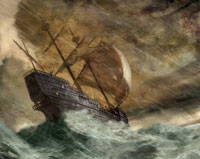
(Excerpted from the October '09 National Geographic.)
This is a story that I will remember for a very long time. Five hundred years ago wealthy Portuguese merchants were outfitting ships to sail on a fifteen month voyage to the East Indies on the route pioneered by Vasco De Gama in 1497. The riches sought were spices and the monies to pay for them included Spanish excelentes and portugueses, with the coat of arms of King Joao III. But also there were copper ingots, a staggering 22 tons of them, in the shape of a half-cannon ball with the trident hallmark of Anton Fugger, one of Renaissance Europe's wealthiest financiers.
Fast forward to April of last year at one of the world's most jealously guarded diamond mines on the coast of Namibia, De Beer's Sperrgebiet ("forbidden zone" in German). A mine engineer finds one of the ingots and immediately halts operations around the cordoned-off find.
Which is no small thing because this riverbed site contains one of the most intense concentrations of high grade diamonds in the world. Washed down to the Atlantic from sites as far as 1,700 miles inland by the Orange River, only the hardest, best quality diamonds make it to this spot, some weighing hundreds of carats. The strong northerly current scattered this lode for miles northward along the coase of Namibia.
Only a few Portuguese East Indiamen or "naus" have been professionally excavated by archaeologists. Most have been plundered by treasure hunters so this is an extra-ordinary find but very difficult to research. In November of 1755 a massive earthquake and tsunami washed the Casa da India, the vast Lisbon archive of maps, shipping records, and charts into the Tagus River.
Without these printed records the researchers had to work backward from clues found on the wreck and one of the most helpful was the rare portugueses of King Joao III. They were minted only from 1525 to 1538 then recalled, melted down, and never re-issued. Their presence onboard along with the copper ingots indicated the vessel was on its outward passage to India rather than returning during this 13 year window.
Eventually researchers learned that the Bom Jesus was brand new and owned by the king himself when it departed Lisbon on 7 March 1533 with 300 souls on board. Reconstructing the story from surviving snippets of information about the fleet historians learned that it was struck and scattered by a huge storm just before the eastward turn around the Cape of Good Hope. Breaking up and drifting north the Bom Jesus eventually grounded 150 yards offshore just 16 miles north of the Orange River.
No one knows what happened to the survivors, if there were any. Local experts say the storms are sometimes so severe that getting ashore is impossible. Yet there are calm days too, and it's possible especially since no human remains were found at the site, that much or even most of the crew made it. If so they must have been desolated by the grim desert environment and the knowledge that rescue was never going to come. Still, the area was visited seasonally by the hunter gatherers we now call Bushmen and they may have helped those who lived through the wreck. But the story ends there. No trace of them remains in the written record.
The exquisite irony of the fabulously wealthy ship owned by a king crashing on a famously rich diamond mine is not lost on the projects researchers. The tale is compelling and a gold-framed window on the past.




No comments:
Post a Comment